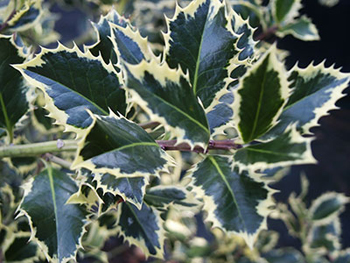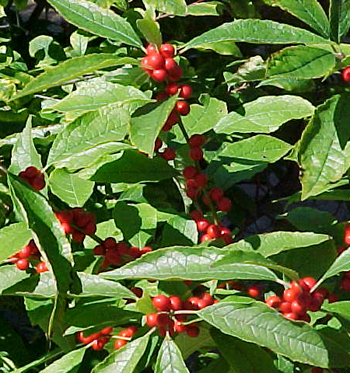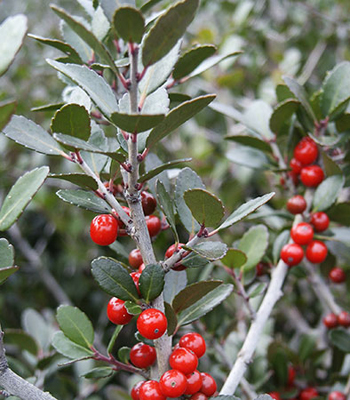Contents:
Common Names | Parts Usually Used | Plant(s) & Culture | Where Found | Medicinal Properties
Legends, Myths and Stories | Uses | Formulas or Dosages | Warning | Bibliography
Scientific Names

- Ilex aquifolium L.
- Aquifoliaceae
- Ilex verticillata L.
- Ilex vomitoria L.
- Holly family
- English holly
- European holly
- Black-alder
- Brook alder
- False alder
- Feverbush
- Striped alder
- Black drink plant
- Emetic holly
- Indian black drink
Mountain Holly
Winterberrry Holly
Yaupon Holly
Common Names
Ilex aquifolium:
Ilex verticillata:
Ilex vomitoria:
Parts Usually Used
Ilex aquifolium: Leaves
Ilex verticillata: Bark, fruit
Ilex vomitoria: Leaves
Back to Top

Description of Plant(s) and Culture
Ilex aquifolium:
Mountain holly is an evergreen tree or shrub; as a tree, it grows as high as 30 feet; as a shrub it reaches about 15 feet. It has smooth bark and green branches, which bear alternate, dark green, shiny, leathery or waxy, spiny leaves. During May and June, small white flowers appear in umbellate clusters, developing on the female plants into pea-sized, red, berry-like drupes which remain through the winter.
Ilex verticillata:
Winterberry is a deciduous shrub, 6-8 feet high; the stems have bluish-gray bark and alternate branches. The leaves are elliptic-ovate or obovate, olive-green, glabrous on top and downy beneath. The plant bears small white flowers from May to July, after which come the pea-sized, glossy, red berries that remain on the stems and branches into winter.
Ilex vomitoria:
Yaupon holly is a small evergreen tree or shrub; its bark is close and whitish-gray; the leaves are alternate, leathery, lance-oval or elliptic, and crenate. The nearly sessile, white flowers grow in axillary clusters from May to June, those on the female plants developing into red, berry-like drupes.
Back to Top

Where Found
Ilex aquifolium:
Grows wild or is cultivated in Europe and is cultivated in the United States for Christmas decorations.
Ilex verticillata:
Common in swamps of eastern North America and in England.
Ilex vomitoria:
Grows in sandy woods and clearings from Florida to Texas, and north into Virginia and Arkansas.
Back to Top
Medicinal Properties
Ilex aquifolium:
Astringent, diuretic, expectorant, febrifuge
Ilex verticillata:
Bark: astringent, bitter tonic, febrifuge
Berries: cathartic, vermifuge
Ilex vomitoria:
Emetic, stimulant
Back to Top
Legends, Myths and Stories
The powers of evil hated the yew and found the holly equally obnoxious, the reason being that the yew was generally found growing in churchyards and the word “holly” is similar in sound to the word “holy”. To the early Christians, however, the thorny foliage and flaming red berries of the holly represented the crown of thorns with drops of blood falling to the ground. They claimed this to be the true reason the herb was magically protective when brought into the home, shielding mortals from evil spirits that wandered over the land during bleak winter months.
According to other legends, holly blessed the home with prosperity and good fortune provided the plant was not removed from the Christmas decorations until the New Year, and in some countries it was never disturbed until Candlemas Day (February 2).
Back to Top
Uses
Ilex aquifolium:
Has been used in the past (little used today) for gout, stones, urinary problems, chronic bronchitis, rheumatism, and arthritis.
Ilex verticillata:
The bark is sometimes mixed with goldenseal to make an infusion for dyspepsia. A decoction of bark is good for external use as a wash for skin irritations and eruptions. Mixed with cedar apples, the berries have been used to make a medicine for worms.
Ilex vomitoria:
Native Americans smoked the leaves or toasted them in clay pots and then made an infusion of them that was drunk for various ceremonial purposes, including purification by vomiting. Dried leaves make a good beverage, if not made into a strong tea, whose caffeine content is mildly stimulating.
Back to Top
Formulas or Dosages
Ilex aquifolium:
Decoction: boil 1 to 2 tbsp. dried leaves in 1 cup water. Take 1 cup per day.
Ilex verticillata:
Decoction: use 1 tsp. root or berries to 1 cup water. Take 1 to 2 cups per day, cold.
Infusion for dyspepsia: use 1 tsp. powdered bark and 1 tsp. powdered goldenseal with 1 pint boiling water. Take 3 to 4 tbsp. at a time, cold, every 1 1/2 hours.
Back to Top
Warning
Ilex aquifolium: The berries are mildly poisonous and are dangerous to small children.
Ilex verticillata: The berries in sufficient quantity can cause poisoning.
Ilex vomitoria: The berries are mildly poisonous and are dangerous to small children.
Back to Top
Bibliography
![]() Eastern/Central Medicinal Plants
Eastern/Central Medicinal Plants, by Steven Foster and James A. Duke., Houghton Mifflin Company, 215 Park Avenue South, New York, NY 10000
![]() The Herbalist Almanac
The Herbalist Almanac, by Clarence Meyer, Meyerbooks, publisher, PO Box 427, Glenwood, Illinois 60425, copyright 1988, fifth printing, 1994
![]() The Herb Book
The Herb Book, by John Lust, Bantam Books, 666 Fifth Avenue, New York, NY. copyright 1974.
Herbal Gardening, compiled by The Robison York State Herb Garden, Cornell Plantations, Matthaei Botanical Gardens of the University of Michigan, University of California Botanical Garden, Berkeley., Pantheon Books, Knopf Publishing Group, New York, 1994, first edition
 The Magic of Herbs in Daily Living
The Magic of Herbs in Daily Living, by Richard Lucas, Parker Publishing Co. (1988).
![]() Webster’s New World Dictionary
Webster’s New World Dictionary, Third College Edition, Victoria Neufeldt, Editor in Chief, New World Dictionaries: A Division of Simon & Schuster, Inc., 15 Columbus Circle, New York, NY 10023
 The Rodale Herb Book: How to Use, Grow, and Buy Nature’s Miracle Plants (An Organic gardening and farming book)
The Rodale Herb Book: How to Use, Grow, and Buy Nature’s Miracle Plants (An Organic gardening and farming book), edited by William H. Hylton, Rodale Press, Inc. Emmaus, PA, 18049., 1974
